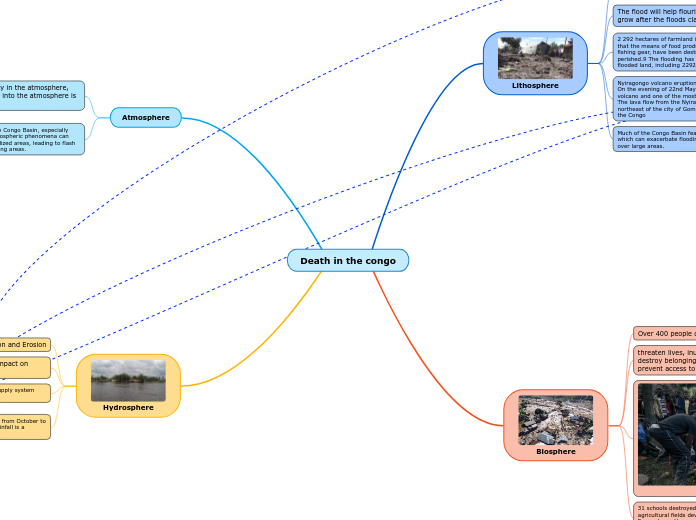Death in the congo
Lithosphere
soil and bank erosion, bed erosion, siltation or landslid
The flood will help flourishes the land for crops to grow after the floods clam down.
has many nutrients from animal waste and such
2 292 hectares of farmland inundated.8 This has raised fears that the means of food production, such as fruit trees and fishing gear, have been destroyed and livestock have perished.9 The flooding has resulted in 346 099 hectares of flooded land, including 2292 hectares of flooded farmland.
Nyiragongo volcano eruption the aftermath
On the evening of 22nd May 2021, Africa's most active volcano and one of the most dangerous in the world erupted. The lava flow from the Nyiragongo volcano flowed to the northeast of the city of Goma in the Democratic Republic of the Congo
Deforestation and land use changes, particularly in the Congo Basin's rainforests, can alter natural drainage patterns and increase the risk of flooding.
Much of the Congo Basin features flat or gently sloping terrain, which can exacerbate flooding by allowing water to spread out over large areas.
Biosphere
Over 400 people dead from the floodings
threaten lives, inundate properties and businesses, destroy belongings, damage vital infrastructure and prevent access to essential public services.
Subtopic
31 schools destroyed and more than 4,300 hectares of agricultural fields devastated in Tanganyika province. Everywhere, the needs are immense. Thousands of families have lost everything.
Atmosphere
increased chances of humidity in the atmosphere, and the evaporation of water into the atmosphere is much higher
Subtopic
warming atmosphere caused by climate change makes extreme rainfall more likely
Thunderstorms are common in the Congo Basin, especially during the wet season. These atmospheric phenomena can generate intense rainfall over localized areas, leading to flash flooding in river basins and low-lying areas.
climate change on flooding in the region are complex and may vary, there is concern that rising global temperatures could exacerbate existing flood risks.
Hydrosphere
Floods Cause Sedimentation and Erosion
pollutants carried by flood water can impact on water quality,
More than 50 per cent of the drinking water supply system destroyed in Kasaï and Tshopo provinces.
During the wet season, which typically occurs from October to April, the basin receives heavy rainfall. This rainfall is a primary driver of flooding in the region.
wetlands play a crucial role in regulating water flow and mitigating floods by acting as natural reservoirs. However, changes in land use, such as deforestation and drainage, can alter the functioning of these wetlands and increase the risk of flooding.
